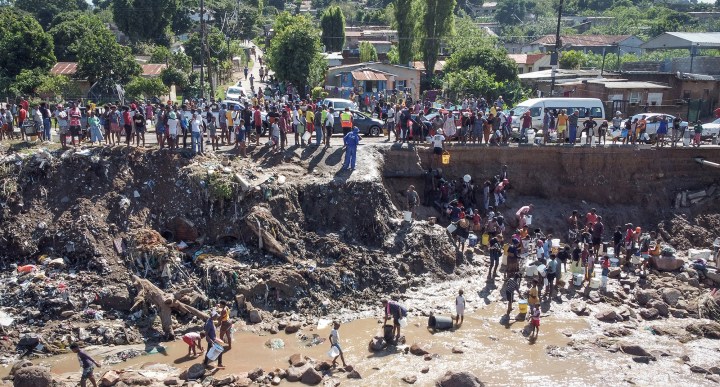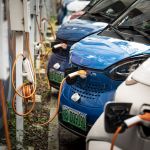PROVINCIAL DISASTER
Weathering the climate crisis in flood-prone Durban — tough lessons from the ‘rain bomb’

Improvements in housing stability are needed across the working-class areas of Durban, as well as for all structures built on vulnerable hills and near the beaches. And much more investment is needed in green infrastructure, including better maintenance of forests, floodplains and wetlands.
Floods have again ravaged eThekwini’s houses, roads and bridges, killing hundreds of people and forcing thousands to take refuge and seek rescue, to evacuate into community halls, or to stay home. Others remain vulnerable, without belongings and homes, in areas without community halls that are stranded without roads and bridges. Torrential rains have caused extraordinary damage to water supply and electrical systems.
The death toll has risen to more than 400, far exceeding the city’s 64 deaths in April 2019, when a “rain bomb” unleashed 168mm in 24 hours, causing R1.1-billion in damage. The previous rainfall record was in October 2017 when 108mm fell, killing 11 people in one day and doing extensive damage, especially around the harbour.
On Monday and Tuesday last week, the skies dumped 351mm of rain, and the failure to maintain already inadequate stormwater drainage systems and ensure sufficiently robust civil engineering was immediately obvious.
The people hardest hit, because they lack resilience and options, are eThekwini’s poor communities in townships, surrounding rural areas and informal settlements. State housing provision and construction standards for thousands of the city’s residential structures were again revealed as inadequate. Of the city’s 550 informal settlements, at least 164 are located in floodplains.
Could the devastating impacts of this year’s pummeling by “rain bombs” have been expected and defences built? While it was clearly “unusual”, this kind of extreme weather will not seem unusual in the coming years.
Ramaphosa vows comprehensive KZN recovery effort, zero corruption tolerance
Inaction
The municipality is often accused of slacking off on climate action, in spite of rhetoric to the contrary. Its Durban Climate Action Plan of 2019 lacks urgency, although it is premised on what climate scientists have been telling us for the past decade, at least: the location of precipitation in South Africa will change, making dry areas drier and wet areas wetter. Extreme weather events will become more common and more intense. We have seen this over the past years when drought devastated large parts of the country, leaving residents without water and threatening food security.
This is the new normal.
After the 2019 “rain bomb” and again this week, President Cyril Ramaphosa visited poor neighbourhoods to survey the damage, promising the mobilisation of funds to assist people in need.
Activists remain unimpressed with the hypocrisy of leaders with direct interests in coal. For more than two decades, they have insisted that the state’s love affair with fossil fuels, mining, high-energy refining and smelting must end. They call for the application of a “polluter pays” principle to raise funds for not only “loss and damage reparations” but also for the necessary climate-proofing investments in poor communities.
With unemployment at nearly 50%, there are pent-up supplies of construction and general workers in communities who can be hired to repair and strengthen drainage systems, construct sturdier houses and safer bridges, restore wetlands and rehabilitate riverine systems to act as a sponge.
Had funding been available beyond the R90-million provided in May-June 2019 to assist with emergency needs (covering just 9% of the April “rain bomb’s” damage), the necessary climate adaptation work could have taken place to help eThekwini cope with last week’s torrential rain and flooding.
After the Covid-19 economic lockdown, in September 2020, Ramaphosa promised to “build back better” by committing the state to hiring 800,000 new workers to assist the more than 1.4 million newly unemployed people. But budget cuts kicked in the following month, which meant funding to repair damaged infrastructure from 2019 did not materialise, and a just transition to assist workers dislocated by climate catastrophe was purely rhetorical.
Climate-resilient investments
What sort of climate-resilient investments are needed?
A first vital step is improving early warning systems and flood preparedness, since the SA Weather Service admitted it had vastly underestimated the storm’s power.
Labour-intensive construction could include more small dams and seawalls, stronger roads and bridge reinforcements, better-quality pipes and water treatment, backup generators for pumping stations and much more effective stormwater drainage.
Most obviously, improvements in housing stability are required across the working-class areas of the city, as well as for all structures built on vulnerable hills and near the beaches. And much more investment is needed in green infrastructure, including better maintenance of forests, floodplains and wetlands.
Over and above its failure to invest in flood-defence and climate-proofing infrastructure, the state — from national to municipal levels — can be charged with negligence for:
- Making only tokenistic nods to climate change impacts, and not adequately taking extreme weather and temperature rise into account for future planning. (Durban’s 2019 plan, bizarrely, describes just one flood event every 10 years, defined as 78mm in 24 hours.)
- Exhibiting self-congratulatory smugness, given that in high-profile forums like the C40 network of cities or the Intergovernmental Panel on Climate Change, Durban officials are praised for strategies mainly based on riverine corridor management (green-zone buffers originally installed during apartheid to enhance racial residential segregation).
- Exuding silence and inaction on public works opportunities that arise not only in disaster reconstruction, but also when it comes to adaptation infrastructure that will, in turn, save resources, since future extreme storms wouldn’t be as damaging.
- Being arrogant and distant, repeatedly attempting to displace informally housed residents (typically without preferable alternatives), facing serious resistance and then — without any evident change of approach — stating in its Action Plan that high-risk informal settlements on hillsides or next to flood-prone rivers have been identified and will be relocated.
- Waging factional turf wars, not only intra-ANC internecine battles, which undermine any intention to a shift to renewables. (eThekwini’s stated target is 40% renewable electricity by 2030.)
- Failing to address operational problems, as witnessed by the sole helicopter available to rescue countless residents who had escaped raging floodwaters by taking refuge on rooftops or in trees.
- Showing no sense of urgency, since most timeframes for Durban’s Climate Action Plan kick in over the next decade or even longer, when preparations for extreme weather events must be an urgent priority.
Given this particular catastrophe, it is up to Durban residents — and all of us in South Africa — to demand of the government that our lives and futures be protected, not neglected. DM
Mary Galvin is an associate professor in anthropology and development studies, and Patrick Bond is a professor in sociology, both at the University of Johannesburg. They write in their personal capacities.
[hearken id=”daily-maverick/9366″]





















 Become an Insider
Become an Insider
Sponges can only absorb so much. The destructiveness of this “rain bomb” is due in large measure to the fact the sponge was already full when the rain bomb exploded. It would have been much worse were it not for Durban’s semi-functioning DMOSS system, not because of the absorbent abilities of wetlands, but rather because well-maintained riverine systems are less prone to erosion. Coal and our reliance on it is not the problem here. The rest of the world will see to it that climate impacts remain the same even if RSA was to adopt the greenies plan and eschew all carbon-based energy. The problem, as I see it, is the lack of resilience which is the inevitable result of a failed state and a consequent failing economy. But for that Durnan infrastructure would work, Durban might have would be able to implement the shelved plans of officials some of whom are world-class. And perhaps we would be looking positively to the future rather than worrying about the future of what is the pillaged ruin of a once functional city.